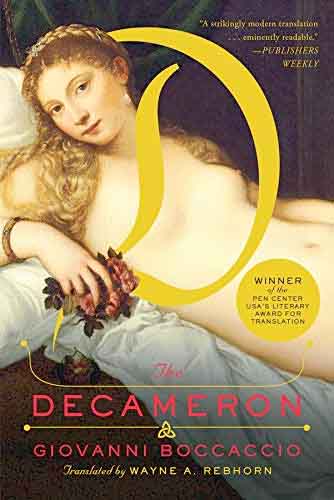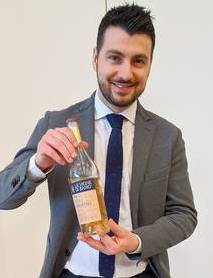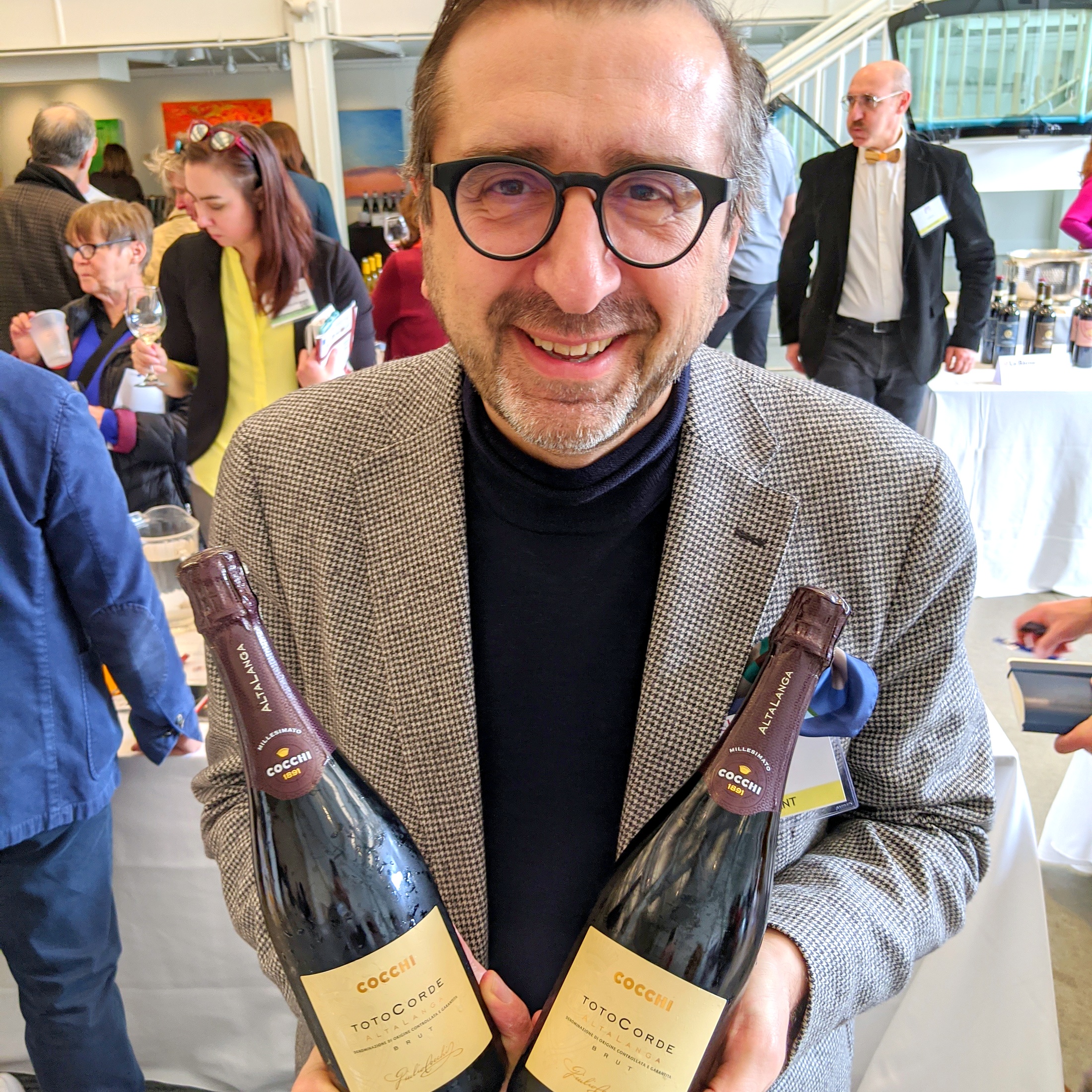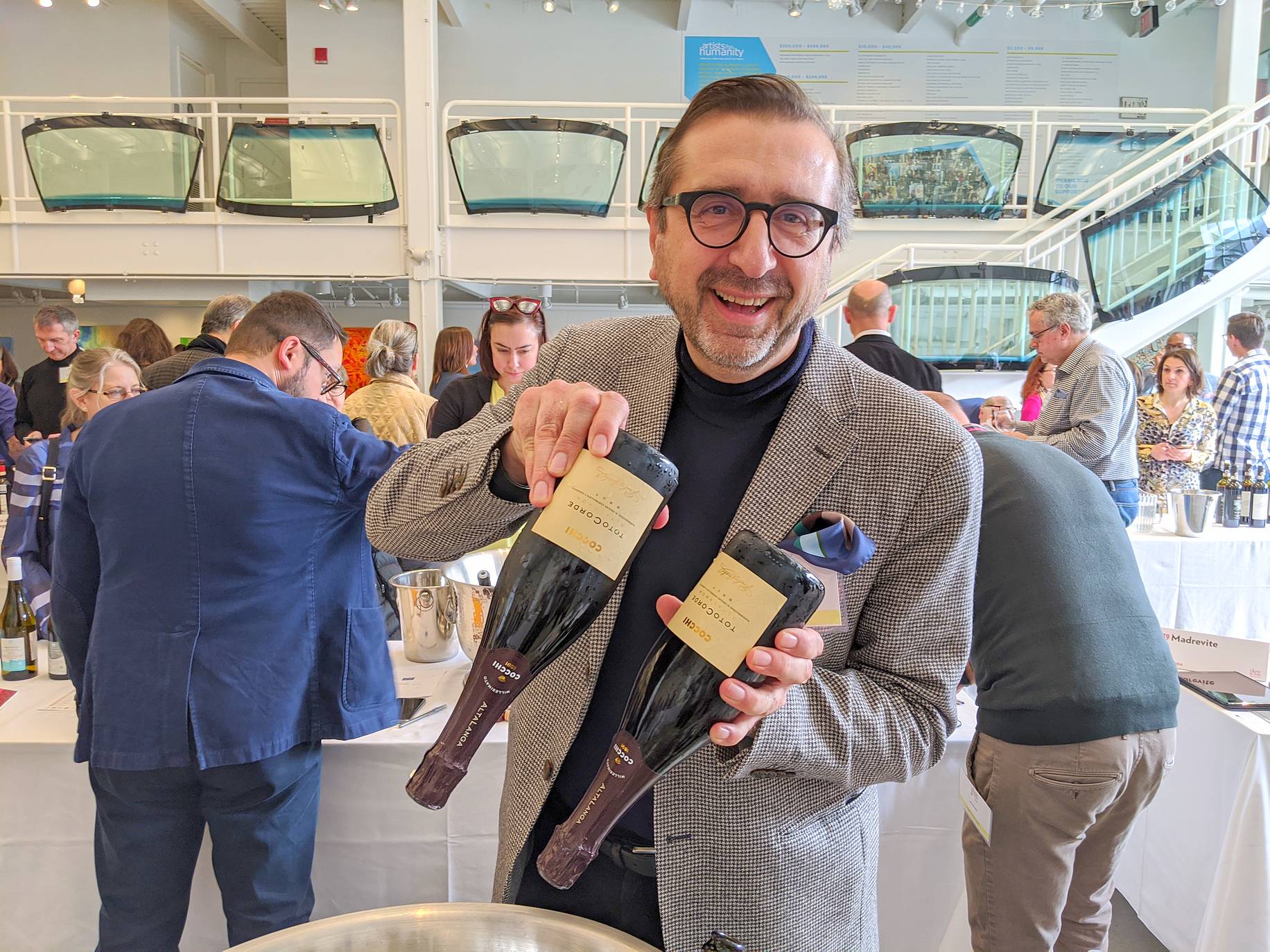The news from Italy, especially in the north, is nothing short of horrific. So quickly has the COVID-19 pandemic moved that everything was transformed in a manner of weeks. As I write this post in mid-March, it’s hard to believe that just three weeks ago (February 25), a few hundred representatives of mostly northern Italian wineries were in Boston for the annual Slow Wine presentation. That’s the irrepressible Roberto Bava of Cocchi (cocchi.it) in the Piedmont at the top of the post.
 Italy has seen such horrors before. The Decamaron by Giovanni Boccaccio is one of the foundational books of Italian literature. The frame story is set in the summer of 1348 as the bubonic plague was ravaging Europe. Three young men and seven young women take refuge in a secluded villa outside Florence and begin telling each other 100 stories. Drawn from ancient literature, current events, and Boccaccio’s own imagination, the tales of love, lust, death, power, corruption, practical jokes, and witty repartee rank as some of the greatest stories ever told.
Italy has seen such horrors before. The Decamaron by Giovanni Boccaccio is one of the foundational books of Italian literature. The frame story is set in the summer of 1348 as the bubonic plague was ravaging Europe. Three young men and seven young women take refuge in a secluded villa outside Florence and begin telling each other 100 stories. Drawn from ancient literature, current events, and Boccaccio’s own imagination, the tales of love, lust, death, power, corruption, practical jokes, and witty repartee rank as some of the greatest stories ever told.
Boccaccio reacted to the Black Death by creating a literary masterpiece. Nearly five centuries later, it still makes good reading while we’re all keeping our distance from each other and coming to grips with a modern pandemic. Here’s a link to buy Wayne A. Rebhorn’s lively translation into American English.
Spreading the word of Slow Wine pour by pour
 Hunkering down and telling each other stories just might be the perfect human response to the challenge of a potentially fatal disease. Storytelling gets back to the essentials—which was the whole point of the Slow Wine tour across the United States (slowwineusa.com) just before life fell apart in Italy. Slow Wine is a branch of the Slow Food movement, which began nearly 30 yeas ago in the Piedmont. Based on the writing and thinking of Carlo Petrini, the Slow Food movement maintains its headquarters in the tiny Piemontese town of Bra.
Hunkering down and telling each other stories just might be the perfect human response to the challenge of a potentially fatal disease. Storytelling gets back to the essentials—which was the whole point of the Slow Wine tour across the United States (slowwineusa.com) just before life fell apart in Italy. Slow Wine is a branch of the Slow Food movement, which began nearly 30 yeas ago in the Piedmont. Based on the writing and thinking of Carlo Petrini, the Slow Food movement maintains its headquarters in the tiny Piemontese town of Bra.
Slow Wine produces an annual guide that divorces wine criticism from tasting panels and numbered scores in favor of highlighting the soul of winemaking. The focus of Slow Wine is sustainable production, stewardship of the terroir, and preservation of biodiversity by cultivating heritage grape varieties. In my experience, the small-producer wines championed by Slow Wine usually possess strikingly authentic and artisanal character. You can taste the place, and you can taste the craft. As ambassadors of the soil where they are grown, they are perfect for ‶bringing the taste of travel back home.″
Zamò’s rebellious streak spells bold Friuli wines
 The majority of the wineries participating in the Slow Wine USA tour hailed from Piedmont, the Veneto, and Friuli. I was delighted to see some of the quirkiest Friuli producers, like Le Vigne di Zamò (levignedizamo.com) showing their wines. Pierluigi Zamò combines the inspiration of the great wines of the Piedmont with the traditions of Friuli to make bold wines with indigenous grapes. His No Name is a mild protest against EU regulations banning the traditional ‶Tocai″ name for a Friulani grape from appearing on labels. (It’s too easily confused with Hungarian sweet wines made from an unrelated grape.) The Friuli grape has been rebranded as Friulano, much to Zamò’s consternation. So he markets his superbly bold and bracing Friulano as ‶No Name.″ Since the Eataly group has a minority ownership in the winery, ‶No Name″ is widely distributed in the U.S. (about $19).
The majority of the wineries participating in the Slow Wine USA tour hailed from Piedmont, the Veneto, and Friuli. I was delighted to see some of the quirkiest Friuli producers, like Le Vigne di Zamò (levignedizamo.com) showing their wines. Pierluigi Zamò combines the inspiration of the great wines of the Piedmont with the traditions of Friuli to make bold wines with indigenous grapes. His No Name is a mild protest against EU regulations banning the traditional ‶Tocai″ name for a Friulani grape from appearing on labels. (It’s too easily confused with Hungarian sweet wines made from an unrelated grape.) The Friuli grape has been rebranded as Friulano, much to Zamò’s consternation. So he markets his superbly bold and bracing Friulano as ‶No Name.″ Since the Eataly group has a minority ownership in the winery, ‶No Name″ is widely distributed in the U.S. (about $19).
Now from Barolo, something completely different
 If there was a single wine that blew me away among the roughly 100 that I tasted at Slow Wine, it was Cocchi’s Alta Langhe TotoCorde 2014. Most producers in the Langhe make muscular reds, either Barolo or Barbaresco. But the limestone-rich Langhe hills boast nighttime temperatures well-suited to cold-climate Pinot Noir and Chardonnay. The resulting wines have a crisp minerality. The best of them are produced as metodo classico sparklers—i.e., with final fermentation in the bottle. There are 38 producers of sparkling wine in the area now, though there were only seven in 2000. As Roberto Bava puts it, ‶Now all the Barolo producers want their own bubbly.″
If there was a single wine that blew me away among the roughly 100 that I tasted at Slow Wine, it was Cocchi’s Alta Langhe TotoCorde 2014. Most producers in the Langhe make muscular reds, either Barolo or Barbaresco. But the limestone-rich Langhe hills boast nighttime temperatures well-suited to cold-climate Pinot Noir and Chardonnay. The resulting wines have a crisp minerality. The best of them are produced as metodo classico sparklers—i.e., with final fermentation in the bottle. There are 38 producers of sparkling wine in the area now, though there were only seven in 2000. As Roberto Bava puts it, ‶Now all the Barolo producers want their own bubbly.″
Cocchi has been making sparkling wine in the area for 129 years, and their TotoCorde (roughly ‶whole heart″) is a standout. Made from 70 percent Pinot Noir and 30 percent Chardonnay, it spends a minimum of 48 months on the lees. The 2014 actually stayed on the lees for 60 months. The resulting toasted bread and white peach aromas complement the vibrant acidity and long, smooth finish. Priced around $40, it’s a steal.

